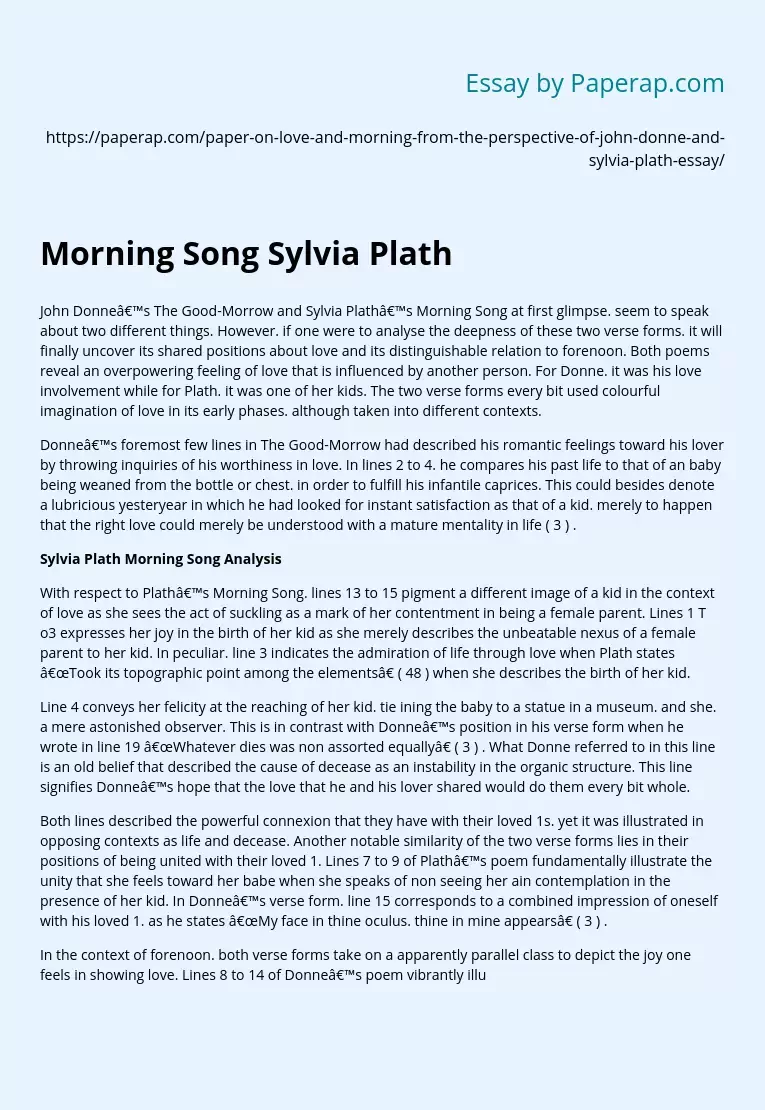Morning Song Sylvia Plath
John Donne’s The Good-Morrow and Sylvia Plath’s Morning Song at first glimpse. seem to speak about two different things. However. if one were to analyse the deepness of these two verse forms. it will finally uncover its shared positions about love and its distinguishable relation to forenoon. Both poems reveal an overpowering feeling of love that is influenced by another person. For Donne. it was his love involvement while for Plath. it was one of her kids. The two verse forms every bit used colourful imagination of love in its early phases.
although taken into different contexts.
Donne’s foremost few lines in The Good-Morrow had described his romantic feelings toward his lover by throwing inquiries of his worthiness in love. In lines 2 to 4. he compares his past life to that of an baby being weaned from the bottle or chest. in order to fulfill his infantile caprices. This could besides denote a lubricious yesteryear in which he had looked for instant satisfaction as that of a kid.
merely to happen that the right love could merely be understood with a mature mentality in life ( 3 ) .
Sylvia Plath Morning Song Analysis
With respect to Plath’s Morning Song. lines 13 to 15 pigment a different image of a kid in the context of love as she sees the act of suckling as a mark of her contentment in being a female parent. Lines 1 T o3 expresses her joy in the birth of her kid as she merely describes the unbeatable nexus of a female parent to her kid.
In peculiar. line 3 indicates the admiration of life through love when Plath states “Took its topographic point among the elements” ( 48 ) when she describes the birth of her kid.
Line 4 conveys her felicity at the reaching of her kid. tie ining the baby to a statue in a museum. and she. a mere astonished observer. This is in contrast with Donne’s position in his verse form when he wrote in line 19 “Whatever dies was non assorted equally” ( 3 ) . What Donne referred to in this line is an old belief that described the cause of decease as an instability in the organic structure. This line signifies Donne’s hope that the love that he and his lover shared would do them every bit whole.
Both lines described the powerful connexion that they have with their loved 1s. yet it was illustrated in opposing contexts as life and decease. Another notable similarity of the two verse forms lies in their positions of being united with their loved 1. Lines 7 to 9 of Plath’s poem fundamentally illustrate the unity that she feels toward her babe when she speaks of non seeing her ain contemplation in the presence of her kid. In Donne’s verse form. line 15 corresponds to a combined impression of oneself with his loved 1. as he states “My face in thine oculus. thine in mine appears” ( 3 ) .
In the context of forenoon. both verse forms take on a apparently parallel class to depict the joy one feels in showing love. Lines 8 to 14 of Donne’s poem vibrantly illustrates the connexion he feels toward his loved one when he likens the meeting to a salutation of psyches as they both start afresh. merely as the morning of a new twenty-four hours signals another twenty-four hours to populate. Donne besides describes this fortunate meeting as an recognition of his loved one’s significance in his universe as he points out that his being simply coincides with the presence of his lover ( 3 ) .
As for Plath. the position of forenoon is entirely dedicated to her joy in being a female parent as she creatively narrates her experiences in nursing her kid. Lines 10 to 15 chiefly depict how she looks frontward to waking up every forenoon as she awakens to the sound of her child’s call due to hunger ( 48 ) . Line 18 of Plath’s poem to the full conceives the impression as to why she looks frontward to anew twenty-four hours. Her forenoon vocal is the call of her babe in the forenoon. depicting it as “The clear vowels rise like balloons” ( 48 ) .
Based on the analysis of Donne’s verse form. one could infer that the mentions made to a kid in depicting childish love is seen as a ephemeral stage from an unconstructive feeling to pure esteem and content. Donne shows the ripening of love as though it was a life and eupneic animal. In Plath’s vision. love was embodied concretely in the bond between parent and kid. specifically between a female parent and her kid. Plath depicts a kind of love that is basic and nurturing ; one that does non anticipate reciprocality or uncertainness. but a deepness of feeling that could merely be felt through the birth of life.
Both of these verse forms have described two types of love that we may see in our life-time and their poetic disclosures indicate that life is riddled with minutes that are full of love.
Plants Cited:
Donne. John. “The Good-Morrow. ” Poems of John Donne. Ed. E. K. Chambers. London: Lawrence & A ; Bullen. 1896. 3. Plath. Sylvia. “Morning Song. ” The Norton Introduction to Literature. Ed. Booth. Alison. J. Paul Hunter. and Kelly J. Mays. 9th erectile dysfunction. New York: W. W. Norton. 1961. 48.
Morning Song Sylvia Plath. (2019, Dec 05). Retrieved from https://paperap.com/paper-on-love-and-morning-from-the-perspective-of-john-donne-and-sylvia-plath-essay/

